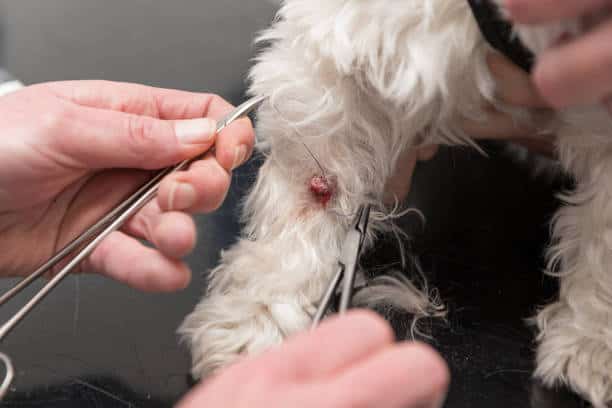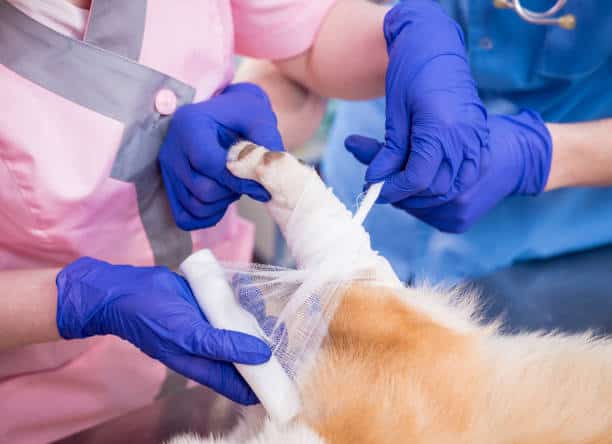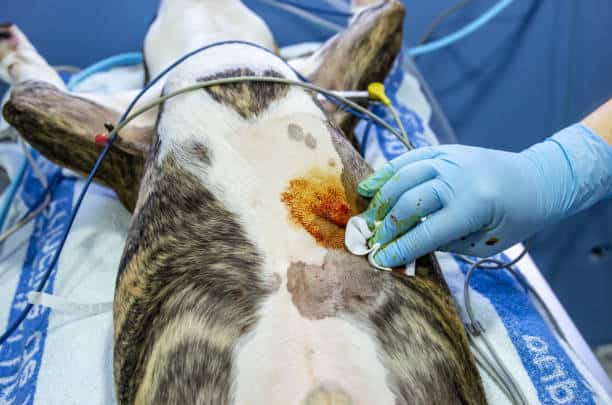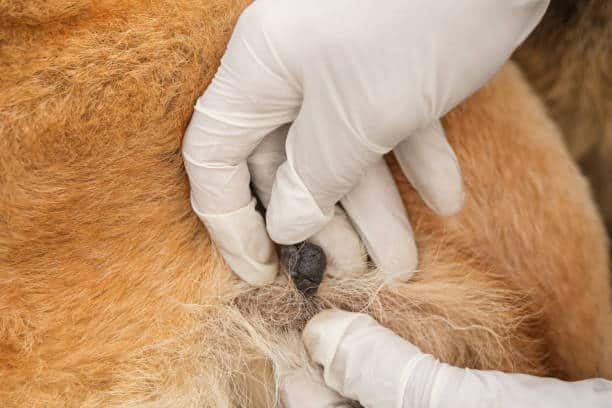Skin tags on dogs, harmless growths, can surface anywhere on the skin but are commonly observed on the trunk, face, sternum, and front armpits. These benign protrusions may also develop on bony areas like elbows, hips, or ankles and possibly near the mouth or on eyelids.
These non-cancerous fibrous growths can appear on any part of a dog’s body and may vary in size, shape, and color. Also known as fibroepithelial polyps, skin tags usually don’t threaten your pet’s health. As a pet parent, you must understand their causes and how they differ from other skin issues and be aware of treatment options if necessary.
What Are Skin Tags On Dogs?
Skin tags on dogs are small, soft, and benign growths that can appear anywhere on the skin, especially in the hair follicles.
Definition And Appearance
Skin tags on dogs, also known as fibrovascular papillomas or acrochordons, are benign, non-cancerous growths that can develop anywhere on the skin. They comprise collagen, blood vessels, and an outer layer of connective tissues.
Their size may vary from just a few millimeters to two centimeters or even larger. Skin tags can be found in various shapes and colors, including flesh-colored, brownish-black skin, or even slightly reddish when irritated.
While these harmless collagenous hamartoma look like warts at times, they differ since they don’t grow back after being surgically removed.

Common Locations On A Dog’s Body
Skin tags on dogs can appear in various areas, but certain locations are more commonly affected. These common locations include:
- Trunk
- Face
- Sternum
- Front armpits
- Elbows
- Hips
- Ankles
- Eyelids
- Mouth
Pet caregivers must regularly inspect their dog’s skin and be familiar with these common areas where skin tags may develop, ensuring the early detection and proper treatment of any issues that may arise.

Causes Of Formation Of Skin Tags In Dogs
Skin tags in dogs can be caused by genetics, age, or friction, and irritation on the skin.
Genetics
Genetics can play a significant role in developing skin tags in dogs, as certain breeds may have a genetic predisposition to these benign growths. Cocker Spaniels, Poodles, and Miniature Schnauzers are some breeds that tend to be more susceptible to developing skin tags.
Understanding your dog’s breed and genetic predisposition can help you stay vigilant about monitoring their skin for any unusual growths or changes. Regular grooming sessions offer an excellent opportunity for pet owners to closely examine their dog’s coat and spot potential issues early on.
Remember that while genetics may increase the likelihood of skin tags forming on certain breeds, you must always consult with a veterinarian when you notice any abnormal growth or change in your dog’s appearance.
Age
Age is also a factor in the development of dog skin tags, as they tend to be more common in middle-aged to older dogs. As dogs age, their skin can become looser and less elastic, making them more prone to developing fibrous growths like skin tags.
Additionally, aging can lead to changes in the metabolism and activity of cells that contribute to the development of skin tags.
It’s important for pet owners with elderly dogs or those predisposed to developing skin tags (such as certain breeds) to monitor their pets’ skin regularly. While most dog skin tags are benign, it’s always best practice for your veterinarian to check any new or changing masses on your dog’s body.

Friction Or Irritation
One of the primary causes of skin tags on dogs is friction or irritation to the skin. This can occur in areas with skin-on-skin contact, such as between skin folds, or from contact with rough surfaces like the ground.
Chronic itchy skin or scratching may also be correlated with skin tags. For example, suppose a dog frequently chews and licks at a particular spot due to an underlying allergic reaction. In that case, it can cause irritation that leads to developing a skin tag.
So it’s clear now what causes skin tags on dogs now lets focus on types of skin tags.
Types Of Skin Growths In Dogs
There are several common type of tags, including warts, ticks, scabs, fatty tumors (lipomas), and mast-cell tumors – learn how to identify and treat different types of skin tags
Warts
Warts are a type of skin growth that can appear on dogs assuming a cauliflower-like appearance. The papillomavirus causes them, appearing as small, rough bumps on the dog’s skin. While most warts are benign, some may be more serious and potentially cancerous skin tags.
Dogs with weakened immune systems or exposed to large numbers of other dogs can be at higher risk for developing warts.
Depending on their location and size, treatment options for wart-like surface include cryotherapy (freezing), laser therapy, or surgical removal under sedation or general anesthesia.

Ticks
Ticks are one of the various types of skin growths that can affect dogs. They often appear as small, dark bumps on a dog’s skin and can sometimes be mistaken for skin tags.
Ticks are external parasites that feed on the blood supply of animals, including dogs. Regularly check your dog for ticks by running your hands through their fur or using a tick comb after outdoor activities in wooded areas or tall grasses.
If you find a tick on your dog, carefully remove it with tweezers by grasping it close to the skin surface and pulling straight up with steady pressure. Be sure to dispose of the tick properly and monitor your dog for any signs of illness afterward.
Scabs
Scabs are a type of skin growth that can occur on dogs, although they are not typically associated with skin tags. They are often the result of an injury or irritation to the skin, such as a scratch or bite.
Allergies or parasites like fleas and ticks can also cause them. Scabs may appear raised or flat and vary in size and color depending on the underlying cause. While most scabs will heal independently within a few days to a week, persistent scabbing may indicate an infection or other underlying health issue that requires veterinary attention.
Fatty Tumors
Fatty tumors, also known as lipomas, are another type of benign growth that can develop on dogs. These soft, round masses are made up of fat cells and can be found anywhere on the body.
Large breed dogs and older dogs are more prone to developing fatty skin tumors.
Mast-cell Tumors
Mast-cell tumors are a type of cancer frequently occurring in dogs, and they can develop within or near skin tags. Mast cells are present throughout the body and play a significant role in an immune response.
However, when these mast cells grow abnormally, mast-cell tumors result. In some cases, skin tags on dogs may not threaten their health; however, pet caregivers must be mindful of their potential risks.
Skin tags often occur in areas with frequent friction or irritation, such as the trunk, face, elbows, and hips, they might lead to inflammation that could exacerbate risk of complications like Mast-cell Tumors.

Procedures For Correct Diagnosis Of Canine Skin Tags
Veterinarians can make a definitive diagnosis through a physical examination and may perform a biopsy or fine-needle aspiration for further testing. So here’s how to remove skin tags on dogs:-
Physical Examination
A physical examination is essential to diagnose skin tags in dogs. During the exam, a veterinarian will carefully examine the dog’s skin and feel for any lumps or bumps.
They may also take note of the size, color, texture, and location of the skin tag. Pet owners must monitor their dog’s skin regularly to detect any new growths or changes in existing ones.
Seek veterinary attention immediately if you notice anything unusual on your dog’s skin, such as an irregular shape or rapid growth rate.
Biopsy Or Fine-needle Aspiration
When diagnosing skin tags on dogs, biopsies and fine-needle aspirations are crucial tools for veterinarians. Biopsy involves removing a small piece of unwanted tissue for microscopic examination. fine-needle aspiration extracts a sample of cells with a thin needle. These diagnostic methods can help distinguish skin tags that may be cancerous or harmful to your dog’s skin health.
Always have a veterinary professional perform these procedures.as improper techniques could cause harm to your pet.
Treatment Plan For Skin Tags On Dogs
Veterinarians may recommend surgical removal, cryotherapy, or laser therapy to treat dog skin tags, depending on the tag’s size and location.
Surgical Skin Tag Removal
Surgical removal may be necessary if your dog’s skin tag is causing chronic irritation, discomfort, or infection. This procedure involves anesthesia and using a scalpel to remove the growth.
Once removed, stitches are used to close the incision site. Surgical removal is not always necessary for every skin tag on dogs, as many grow benignly. However, if you notice changes in color, size, or texture of your dog’s skin tags, including other body parts, it’s best to consult a veterinarian. Based on diagnostic tests like cytology or histopathology, he can determine whether surgical intervention is needed.
Cryotherapy For Skin Tag Removal
Cryotherapy is a potential treatment option for removing skin tags on dogs. This process involves freezing the skin tag with liquid nitrogen or nitrous oxide. It can be an effective method for removal with minimal damage to fibrous tissue.
However, cryotherapy must be performed under anesthesia. Also, the area must be closely monitored after the procedure. Cryotherapy is not recommended for skin tags around the eye or genital area.
Other treatment options for skin tags on dogs include surgical removal, electrocautery, and topical treatments such as ointments or sprays.
Laser Therapy Treatment Plan
Laser therapy is a treatment option for skin tags on dogs that involves using a focused beam of light to remove the growths. These cosmetic reasons have become increasingly popular in recent years due to its effectiveness and minimal risk.
Unlike traditional surgery, laser therapy does not require general anesthesia, making it less stressful for pets and their owners. Additionally, laser therapy results in less bleeding and hypertrophic scar than other surgical methods.
Wag! offers resources for pet caregivers interested in exploring treatment options for their furry friends’ skin conditions.

How To Prevent Fleshy Skin Growth In Dogs?
Regular grooming and monitoring for irritation signs can help prevent growths of skin on dogs.
Regular Grooming
Maintaining a regular grooming routine is important to prevent skin tags from forming on your dog. Here are some tips for keeping your dog’s skin health on point and free of irritation:
- Brush your dog’s coat regularly to remove dirt, debris, and loose fur that can cause friction and irritation.
- Clean your dog’s skin folds (if applicable) with a damp cloth or specialized wipes to prevent bacterial infections.
- Bathe your dog with a mild shampoo every few months to keep their skin clean and reduce the chance of skin irritations that can lead to skin tags.
- Trim any long or sharp nails that may scratch or injure the skin, leading to potential skin tag growths.
- Check for any unusual skin lumps or bumps on your dog’s body during grooming sessions – if you notice anything out-of-the-ordinary, consult a vet.
As a rule of thumb, incorporating these habits into your pet care routine can minimize the risk of your dog developing pesky skin tags. Also, regular grooming helps maintain a healthy skin for overall canine well-being.
Monitoring For Signs Of Irritation
It is essential to keep an eye on skin tags in dogs for signs of irritation, as they can become inflamed or infected. Signs of irritation may include excessive licking and chewing in one spot, redness, swelling, bleeding, or discharge.
Get medical intervention if you notice any changes in size, shape, or color of the skin tag or if your dog appears to be experiencing discomfort around the area.
Keeping your dog’s coat clean and well-groomed can also reduce the risk of skin tags forming due to friction or irritation. Maintaining a healthy weight for your pet and providing proper nutrition can promote overall canine health while reducing their susceptibility to food allergies that may cause these benign growths.

Maintain A Healthy Weight
Maintaining a healthy weight in dogs is crucial to prevent the development of skin tags. Excess weight puts pressure on the dog’s skin, resulting in repetitive friction and irritation that lead to skin tag growth.
Regular exercise and feeding your dog a balanced diet containing high-quality protein and essential nutrients can help maintain a healthy weight. Monitoring your dog’s caloric intake by measuring food portions can prevent overeating and excessive weight gain.
Prognosis For Dogs With Skin Tags
The prognosis for dogs with skin tags is generally good. Skin tags are considered a benign skin growth and rarely pose any health risk to your furry friend.
Surgical removal is often recommended if a skin tag becomes damaged or infected. Prevention is key in avoiding the development of new skin tags on your furry friend. Regular grooming can help reduce friction-related skin tags while maintaining a healthy weight can also minimize their occurrence.
FAQ
How Do You Get Rid Of Skin Tags On A Dog?
The most common treatment for skin tags on dogs is surgical removal. Depending on the size and location of the skin tag, either local anesthesia or general anesthesia may be used.
The growth is cut off with scissors or a scalpel, then stitched up if necessary. Cryotherapy and laser therapy are options for removing skin tags, but they can be more expensive than surgery.
Pulling off a skin tag at home can be dangerous and should never be done as it risks causing excessive bleeding and secondary infections.
Can You Pull Skin Tags Off Dogs?
Pulling skin tags off dogs is not recommended, as it can cause pain, bleeding, and infection. Attempting to remove the skin tag yourself may also lead to misdiagnosis of the condition and delay proper treatment.
It is important to have a veterinarian evaluate any growths on your dog’s skin before attempting any removal. They can determine whether it is a skin tag or another type of growth requiring more specialized treatment.
When Should You Worry About A Skin Tag On A Dog?
It’s normal to be concerned when you notice a skin tag on your dog, but usually, they are harmless skin growth. However, if the skin tag is bleeding, infected or an unusual color and shape, it may be cause for concern.
To ensure proper diagnosis and treatment options for your dog’s condition, take them to see a veterinarian who can examine the growth and determine further actions.
Irritated skin tags are not considered dangerous and do not require immediate intervention unless they become problematic.
What Does A Dog Skin Tag Look Like?
A dog skin tag can look like a small, fleshy growth on their skin that may be raised or flat. These tags can vary in texture and appearance, with some being firm and others feeling soft and squishy.
They range from a few millimeters to two centimeters or larger and can have stalks or be attached directly to the skin. Suppose you notice any strange growths on your furry friend’s skin. In that case, getting them checked out by a vet to rule out other potential health concerns, such as cancerous tumors, is important.
Author Profile

- Lifetime dog Enthusiast
- Shradha is a seasoned writer at Labradorandyou.com, an authoritative resource for all things Labrador Retriever. Her experience as a pet owner and dog enthusiast drives her to create meticulously researched and fact-checked content, offering valuable insights on Labrador training, grooming, and health. Each article reflects Shradha's passion and dedication, enriched by personal experiences with her beloved Labradors, Tom, and Kurt. Whether exploring breed-specific training techniques or providing product reviews, Shradha ensures Labrador owners receive the most accurate, up-to-date, and trustworthy information, aimed at enhancing their companions' health and happiness
Also by the author
-
 Lab-TypesJuly 2, 2025Vovan Казино Официальный Сайт Казино С Азартными Играми
Lab-TypesJuly 2, 2025Vovan Казино Официальный Сайт Казино С Азартными Играми
-
 Lab-TypesJuly 2, 2025Download 1xbet APK Latest Version and Unlock the Best Betting Benefits
Lab-TypesJuly 2, 2025Download 1xbet APK Latest Version and Unlock the Best Betting Benefits
-
 casinoJuly 2, 2025“gerçek Paralı Casino Oyunları: Türkiye’de En İyi Siteler Ve Oyunlar
casinoJuly 2, 2025“gerçek Paralı Casino Oyunları: Türkiye’de En İyi Siteler Ve Oyunlar
-
 Lab-TypesJuly 2, 2025Zakłady Sportowe Online Firma Bukmacherska 1xbet
Lab-TypesJuly 2, 2025Zakłady Sportowe Online Firma Bukmacherska 1xbet





